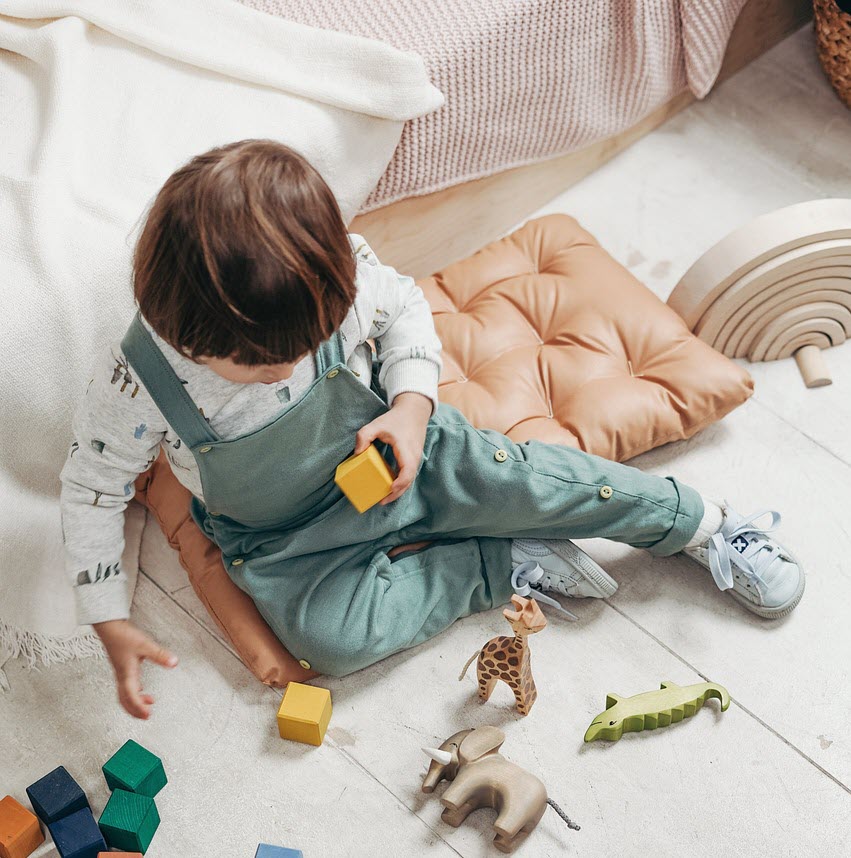
Depending on the sensory processing disorder (SPD), the best assistive devices for specific conditions can range from low-tech options to more advanced ones. Either way, the devices should engage the child and encourage enjoyment to motivate effective use.
1. Mini Carillon by Enabling Devices
Image: Enabling Devices
With the Mini Carillon by Enabling Devices, kids with auditory processing disorders receive an effective introduction to music that helps with their aural development. Eight precision bells combined with six color-coded cards allow youngsters to learn to play favorite songs, including “Mary Had a Little Lamb” and “Twinkle, Twinkle” by simply pushing the related color button.
As they develop further, children can also compose custom tunes or enjoy seven prerecorded songs, like “Old MacDonald” and “Row Your Boat.” Teachers can show their learners the meaning of cause and effect — the direct relationship between pushing the buttons in order and the resulting tune. Use the Mini Carillon to promote earlier musical appreciation in kids with auditory SPDs and others.
- Price: $529.95
- Dimensions: 10.5 inches x 6.5 inches x 13.75 inches
- Weight: 6 pounds
- Batteries: 4 C/4 AA batteries
- Age group: Suitable for young children under recommended adult supervision
2. Deluxe Jellyfish Lamp by National Autism Resources
Image: National Autism Services
The National Autism Resources Deluxe Jellyfish Lamp is ideal for creating a calming visual focal point to assist in the relaxation of students with SPD. Visualization techniques help them combat the anxiety and nervousness that lead to fight-or-flight responses.
After adding the two large jellyfish to the tower along with water and a touch of dish soap, they glide and slowly change colors under the ambient lighting. With blue, green, pink, red and yellow colors in 18 different LED lights, the Deluxe Jellyfish Lamp’s calming focal point helps reduce the unsettling effect of visual SPD and teaches abstract visualization and imagination concepts.
- Price: $109.99
- Dimensions: 18 inches x 5.5 inches x 5.5 inches
- Power: Electric with a low-voltage adapter
- Age group: 15 years and up, with suggested adult supervision for lower ages
3. Vibrating Snake by Special Needs Toys
Image: Special Needs Toys
The Vibrating Snake is one of Special Needs Toys‘ top-selling sensory products. It assists children with tactile SPD in acclimating themselves to touch in a manner that promotes relaxation and calm. In addition, the battery-operated vibration helps them understand where they and their body parts are within a space, assisting with balance and coordination.
The snakes come in ridged green and orange, with a smooth blue design available for young ones with tactile sensitivities. Use the flexible device’s two included speed settings to stimulate their proprioceptive senses by wrapping it around their neck, back, torso, arms or legs. The soft vibrations act to relax them in the required area.
- Price: $41.00
- Dimensions: 49 inches x 1.5 inches x 1.5 inches
- Weight: 1.2 pounds
- Batteries: 2 x C batteries not included
- Age group: Suitable for children under adult supervision
4. Weplay Rocky Hill by Kaydan Sensory Solutions
Image: Kaydan Sensory Solutions
Weplay Rocky Hill is a balance board from Kaydan Sensory Solutions. It’s excellent for younger SPD children’s proprioceptive development and vestibular input. The hill is spiral-shaped with small rock-like obstacles and tilts to different sides as a child places their feet on one of the layers. The jumbo Rocky Hill has space for two toddlers to work together, improving teamwork and balance.
A younger kid can also lie or sit on the device — its wobbling and rotating characteristics further develop vestibular skills. The Weplay Rocky Hill without its base also serves as a stable stepping platform with a circular path for toddlers to step on. With the base connected, the device is an effective balancing tool for slightly older children during play.
- Price: $290.50 (Equivalent)
- Dimensions: 34 inches x 31 inches x 10 inches
- Weight: 13.9 pounds
Batteries: None - Age group: Two years and over
How Assistive Devices Assist Children With SPD
Every youngster will experience SPD differently. They could be underresponsive, meaning an effective assistive device promotes more intense sensory input. Alternatively, tools that provide that input may overwhelm a child with overresponsive SPD.
For this reason, it’s vital to identify its effectiveness for catering to every kid’s specific SPD — auditory, visual, vestibular, tactile, proprioceptive or others. Companies design assistive devices to include in the child’s daily routine and promote continual sensory regulation through various activities.
However, the goal must be to use it to encourage a student’s independence and successful functionality without relying on it. Using top-rated assistive devices in conjunction with guidance from a qualified occupational therapist or another specialized professional and regular assessments helps to integrate practical tools for short-term and long-term sensory development.
SPD Assistive Devices of All Types are Crucial
No matter the type of SPD, assistive devices help better manage sensory input, develop focus, regulate emotions, and enhance overall well-being and performance in children of various age groups experiencing sensory sensitivities or processing difficulties. These tools can enable more inclusive and supportive environments for diverse learners and individuals with significant processing challenges.







